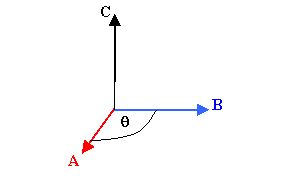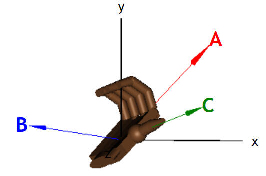 The magnitude of C is C = A B sinθ, where θ is the smallest angle between the directions of the vectors A
and B. C is perpendicular to both A and B, i.e. it is
perpendicular to the plane that contains both A and B. The direction of C
can be found by using the right-hand rule.
The magnitude of C is C = A B sinθ, where θ is the smallest angle between the directions of the vectors A
and B. C is perpendicular to both A and B, i.e. it is
perpendicular to the plane that contains both A and B. The direction of C
can be found by using the right-hand rule.Let the fingers of your right hand point in the direction of A. Orient the palm of your hand so that, as you curl your fingers, you can sweep them over to point in the direction of B. Your thumb points in the direction of C = A × B.

